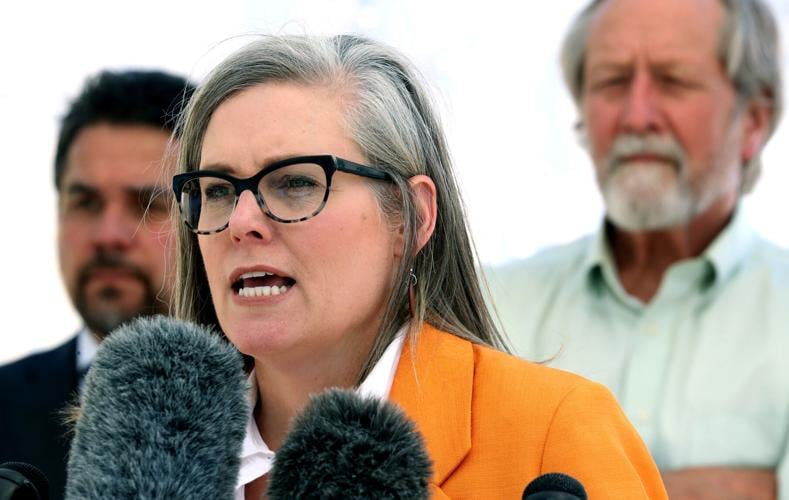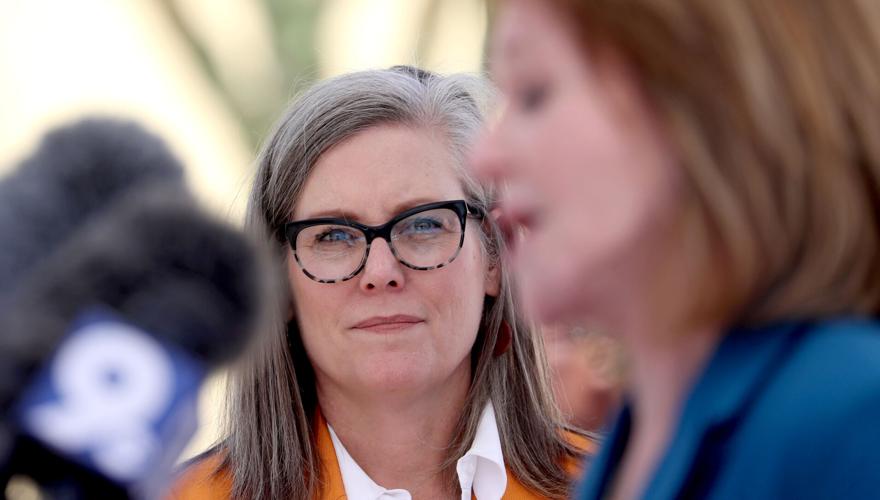Some Arizona politicians are busily telling us that the Biden administration is not prepared enough to lift Title 42 border restrictions.
Sen. Kyrsten Sinema, the newly minted Independent, keeps saying it. Republican Rep. Juan Ciscomani says so too. Even Democratic Gov. Katie Hobbs has taken up the refrain.
“With Title 42 set to expire in just two days, it doesn’t appear the federal government is prepared,” Hobbs said Tuesday afternoon in Tucson. “As a result, Arizona communities will face incredible challenges trying to deal with the influx of people entering the country.”
Maybe they’re right, maybe they’re wrong. It’s often hard to tell when politicians talk about the U.S.-Mexico border, because the temptation to hype is so strong. In any case, we’ll find out soon enough, because Title 42, the pandemic policy that allows Border Patrol agents to return many migrants to Mexico immediately, expires at the end of the day Thursday.
Part of what confuses me is our long experience with surges in migration, experiences that we have, by and large, dealt with.
But also, there’s this: The chief of the Border Patrol’s Tucson Sector, John Modlin, sounded much more confident than these politicians did when he spoke at a news conference Monday:
“Over the last 18 months to two years, there’s probably been six or seven times that we thought Title 42 was going away. We built incredible relationships over this year and a half, especially outside the federal government. Relationships that we didn’t always have before.”
He said the patrol is in “day-to-day contact with the counties, the municipalities, the non-governmental organizations.”
“I think we are incredibly well-prepared for it.”
So if the Border Patrol chief is confident, why are the politicians speaking so fearfully? Maybe they know something he doesn’t. Or maybe they are protecting themselves politically from blame if things do go wrong.
If they do, each can say, “I told you so,” and that it wasn’t their fault.
If things go right, and there isn’t much disturbance to day-to-day life in Arizona once Title 42 is rescinded, nobody will remember that they cried wolf.
On-the-ground reality is rarely the issue when it comes to talking about migrants and the U.S.-Mexico border. Perception and political position are what really matters when politicians are talking.
If it benefits them, they will say the border is in chaos even when it isn’t, or if the problems are isolated to one part of the Rio Grande Valley, hundreds of miles from Arizona. And yes, if it benefits them, they will say the border is under control, even if it isn’t.
In short, you cannot trust what politicians say about the border.
In places like Tucson and the borderlands of southern Arizona, though, we have the benefit of being able to judge from our own experiences.
I’ve had the chance over the last few years of welcoming groups of foreign journalists who come to the USA on the State Department’s Edward R. Murrow exchange program. They always want to talk about migration and occasionally ask about our recent experience in Tucson.
They’ve all heard the news reports about surging irregular migration along the Mexican border and in Arizona.
My answer, even in these Biden years when more migrants have been coming across than during the pandemic’s first in 2020, has been this: In Tucson, I have noticed no signs in my daily life of an increased presence of migrants. The only times I’ve come across them is when I’ve been working on stories about them.
For me personally, the much bigger impact was in the spring of 2019. That’s when thousands of migrants from Honduras, other Central American countries and southern Mexico passed through Tucson. A church near my house had a small shelter where I volunteered, and of course the monastery on North Country Club Road was turned into a miraculous locus of shelter and logistics for migrants.
Now, I expect there to be problems cropping up with the end of Title 42. It will probably be most noticeable in towns like Douglas and Bisbee, Ajo, Gila Bend and maybe Yuma County. If the Border Patrol starts dropping people off without coordination in those places, that will be a problem.
In fact, that seems to be the principal concern of Hobbs and the local officials who spoke at the new Casa Alitas shelter on Tucson’s south side Tuesday. They don’t want so-called “street releases” of migrants with nowhere to go. And then, they want to be sure there is shelter space for those people who do arrive, at least until they can be sent on to their friends or family elsewhere in the country.
“We’ve seen them (Border Patrol) not communicating where they’re dropping people off. We’re trying to avoid street releases,” Hobbs said. “They might think they have a plan, but they have not communicated that plan to us.”
But our experience has shown that, between the local governments, non-governmental organizations like Casa Alitas, local volunteers and, yes, the federal government, we can withstand the crisis periods that have occurred occasionally for decades.
Not to mention, the Biden administration does have a detailed plan that ought to have some effect. In fact, it’s considered draconian by many human rights activists.
A new rule, likely to go into effect before Title 42 expires, would prohibit anyone who crosses the border between ports of entry from seeking asylum. That alone would be a massive change, funneling all asylum seekers through ports of entry.
Among other things, they are also increasing the number of hearing officers for credible-fear claims, increasing deportation flights, and setting up regional processing centers around the hemisphere, for people to visit instead of making a perilous journey.
Much of the rest of what needs to be done, though, is up to Congress. Ciscomani and Sinema, Rep. Raul Grijalva and Sen. Mark Kelly — they’re the ones who need to take charge of changing laws and funding to address the deeper, longer-standing problems.
As to the current problem, we’ll find a way to muddle through.





